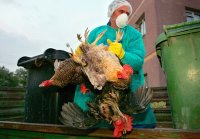| Some Stuff |
|
| Some MORE Stuff |
|
|
| Avian Influenza (Bird Flu) |

Bird flu is an infectious disease caused by avian influenza viruses. It is seen in chickens, ducks, and other types of birds. These viruses are very contagious among animals and on rare occasions they have crossed the species barrier to infect humans.
Among these influenza viruses it is the H5 and H7 subtypes which cause highly pathogenic disease. It is the H5N1 virus which has caused the largest and most severe outbreak on record causing the death of so many birds.
The big question is that, is there a risk for human health? Yes, there is. First, there is a risk of direct infection when the virus passes from poultry to humans. Another risk is that this virus (H5N1) has the capability of changing into a very infectious form which can infect humans and then transfer easily from person to person. It this happens, this could lead to a major flu outbreak or a pandemic.
In order to start an influenza pandemic, there are three conditions that have to be met: emergence of a new virus subtype, this virus is able to infect and cause disease in humans, and this virus can spread easily and efficiently among humans. The third condition has not been fulfilled yet. As long as the H5N1 virus continues to infect birds, there is still the risk that this virus will meet the third condition.
How do we get infected? The main mode of transmission is by close contact with live infected birds and to objects contaminated by their feces. These infected birds excrete large quantities of the virus in their feces so that there is high exposure in poultry workers, people living in poultry farms, and people selling live poultry. People who work in slaughter houses and those who prepare poultry for cooking are also at high risk of contracting the disease. Cockfighting can be another way of spreading the disease. The mere flapping of the bird’s wings increases incidence of transmission.
The signs and symptoms of bird flu resemble those of conventional influenza. There are about 2 to 8 days (average 3 days) from exposure to the appearance of symptoms. The symptoms include fever, cough, muscle pain, and sore throat. Individuals with more virulent type of virus may develop acute respiratory distress or viral pneumonia which are more life-threatening.
Bird flu vaccine are not yet available commercially. This vaccine still needs to be tested and licensed. There are antiviral flu drugs which can be used in case of human transmission. Since the virus is easily killed by thorough cooking and since avian flu is not transmissible through food, it is safe to eat chicken. |
|
|
|
|
|